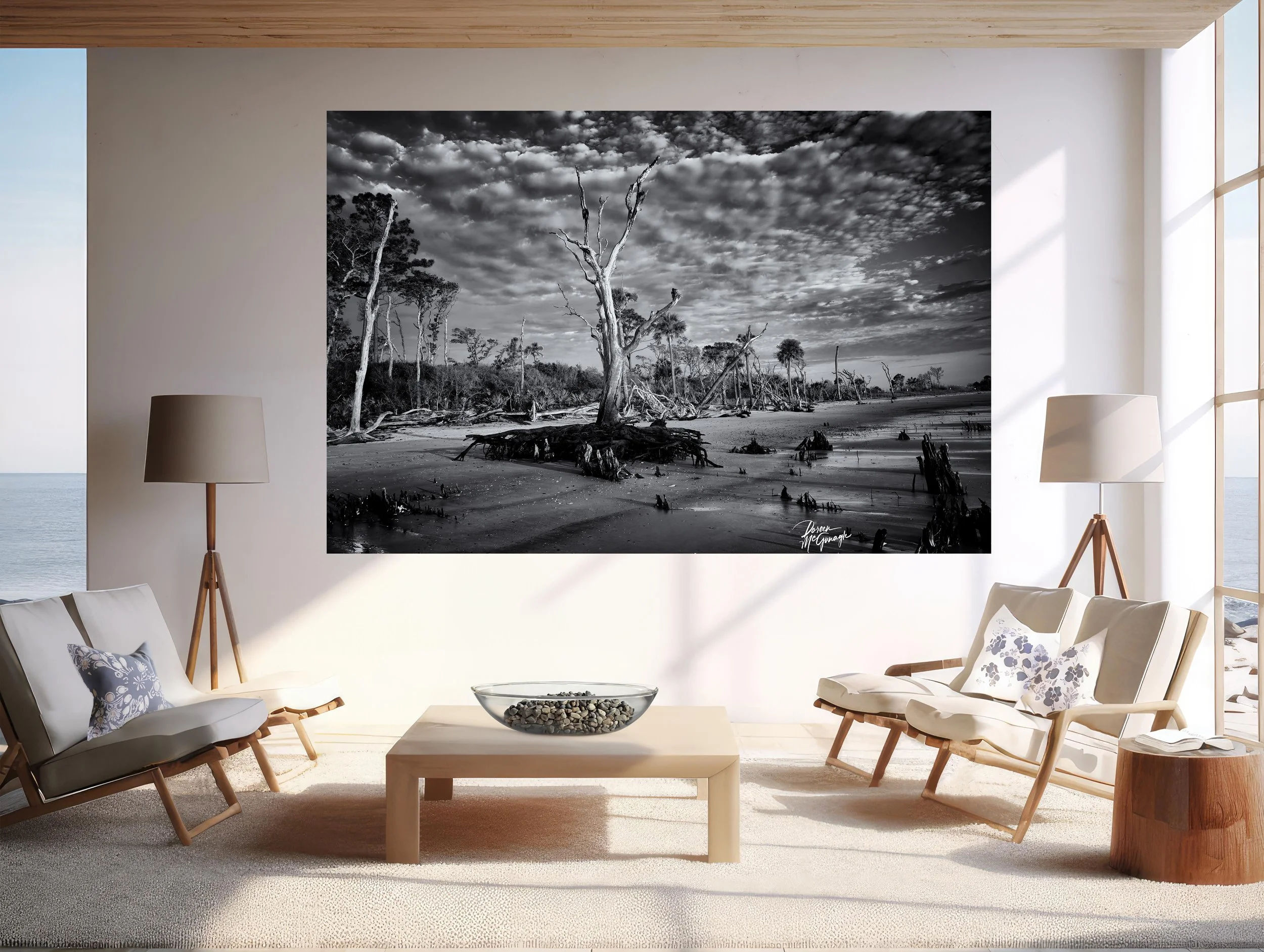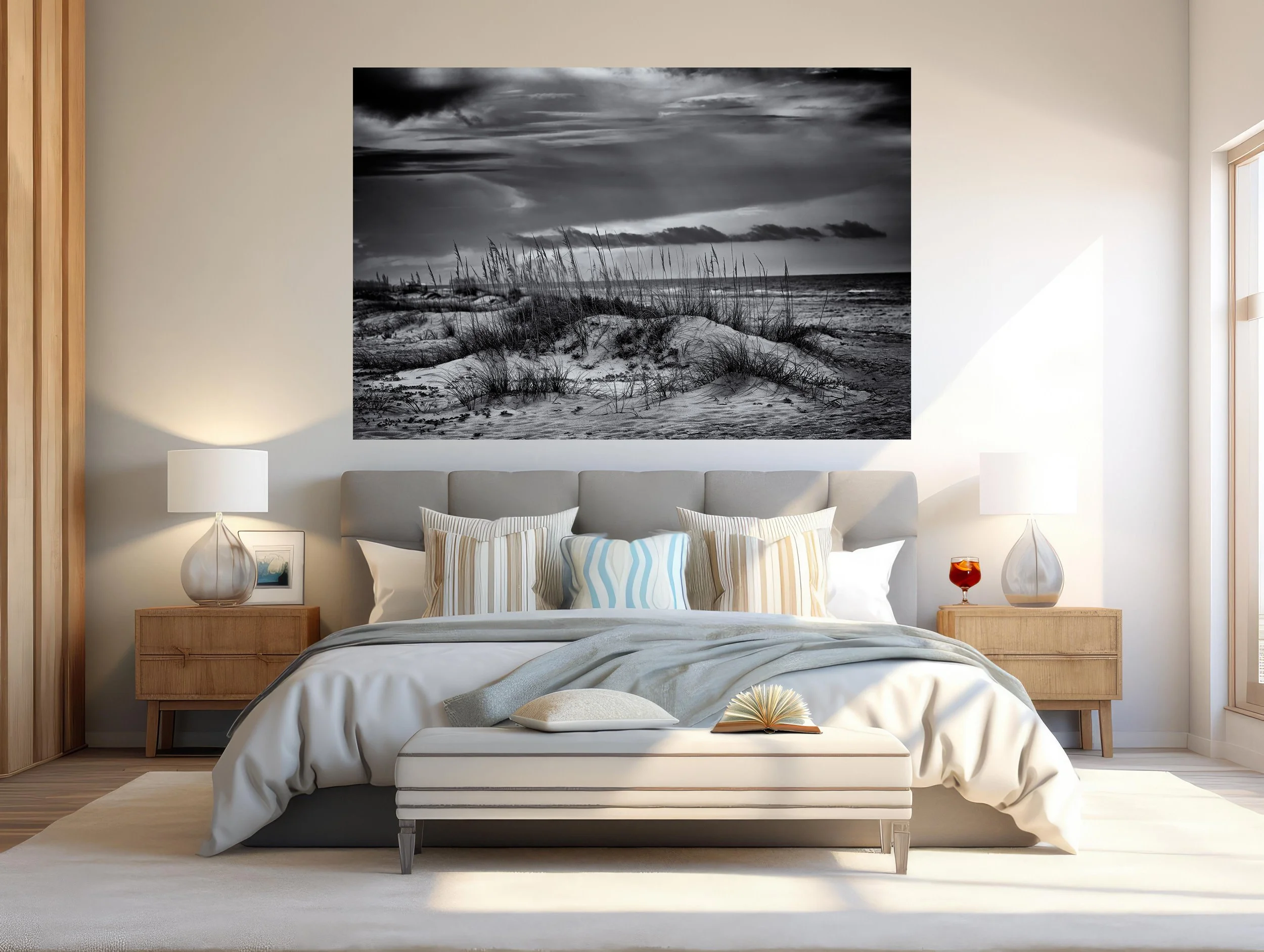Capturing the Beauty of Monochrome Landscapes
Monochrome landscapes hold a unique allure to fine art nature photography. These images are stripped of color and rely on contrast, texture, and form to convey their beauty.
Ethereal Solitude
The composition skillfully centers around a barren, leafless tree set against a lonely beach or shoreline dotted with scattered tree stumps and pieces of driftwood. The dramatic and textured clouds that fill the expansive sky add depth and a grand sense of scale to the scene..
Large Wall Art, Limited Edition 20
Ethereal Solitude: Boneyard Shoreline JAX 214-13BW c2024 | Florida | Learn more
This guide delves into the art of capturing nature in black and white. We explore techniques, aesthetics, and the emotional depth of monochrome photography.
Whether you're a seasoned photographer or a beginner, this exploration of monochrome landscapes will inspire you to see the world in a new light.
The Allure of Monochrome Landscapes
Monochrome landscapes offer a different perspective on nature. They highlight the raw beauty of the natural world, emphasizing shapes, textures, and contrasts.
Tranquil Shadows
The dune subtly guides the eye toward the endless, calm ocean horizon beneath a dramatic, textured sky. Layers of clouds collaborate with the interplay of light and shadow to create depth and evoke a profound sense of tranquility.
Large Wall Art Edition 20
SGI 5356_04BW c2024 | Florida | Learn more
The absence of color allows viewers to focus on the scene's elements. Monochrome landscapes are about the interplay of light and shadow, the starkness of lines, and the subtlety of tones. This simplicity is what makes them so captivating and timeless.
Monochrome vs. Color: A Study in Contrast
Monochrome and color photography each have their unique appeal. Color captures the world as we see it, vibrant and full of life.
On the other hand, monochrome strips away the distraction of color. It forces us to see the world in a new light, focusing on the scene's essence.
In essence, monochrome photography is a study, in contrast, a dance between light and dark.
Techniques for Capturing Monochrome Landscapes
Capturing monochrome landscapes requires a keen eye for detail. It's about finding beauty in simplicity, in the play of light and shadow.
The absence of color emphasizes textures and shapes. It brings out nature's raw beauty, stripped down to its core elements.
Understanding the nuances of light is crucial. It's the key to creating dynamic black-and-white landscapes.
Lighting and Composition
Lighting plays a pivotal role in monochrome photography. It can transform an ordinary scene into a dramatic landscape.
The right balance between dark and light can create a sense of depth and highlight the textures and shapes in the scene.
Remember, in monochrome photography, it's all about the contrast.
Camera Settings and Equipment
The choice of camera settings and equipment can significantly influence the outcome. A low ISO setting can help maintain the quality of the image.
A tripod can provide stability, especially in low-light conditions, and help compose the shot.
Filters can enhance contrast and detail in black-and-white images.
Post-Processing for Impact
Post-processing is an integral part of monochrome photography. It allows you to refine your images to bring out the best in them.
You can adjust the tonal range, enhance the contrast, or add a touch of grain for a vintage feel.
Remember, the goal is to create an image that resonates and tells a story. It is where black-and-white images come to life.
Visualizing the World in Black and White
Visualizing in black and white is a skill that can be honed with practice. It involves seeing beyond the colors and focusing on the elements that make up the scene.
Look for patterns, textures, and contrasts. These elements can create a compelling composition in a monochrome image.
Remember, a good black-and-white image is not just a color image converted to grayscale. It's a different way of seeing the world. Usually, I can tell when I am taking a picture that will be modified to black and white.
The Emotional Impact of Black and White Nature Photography
Black-and-white nature photography has a unique emotional depth. The absence of color can evoke a sense of nostalgia, timelessness, and sometimes melancholy.
The stark contrast between dark and light can also create drama. It can highlight the struggle and harmony that often exist in nature.
In essence, monochrome landscapes can stir emotions that color images may not. They invite viewers to see the world from a different, often more introspective, perspective. I successfully learned how to shoot and process black-and-white images in high school. I had my darkroom, which allowed me to hone my skills.
Conclusion: Embracing the Monochromatic Perspective
Monochrome landscapes offer a unique perspective on the natural world. They strip away the distraction of color, allowing the viewer to focus on form, texture, and contrast.
Embracing this perspective can be a rewarding challenge for any photographer. It requires a keen eye for light, composition, and the subtle nuances of grayscale.
In the end, the beauty of monochrome landscapes lies in their simplicity and depth. They capture the essence of nature in its raw, unadorned form, offering a timeless and evocative view of the world around us.
Explore our online gallery of limited-edition conservation fine art prints. Join us in celebrating and preserving the beauty of our natural world through our exquisite collection of fine art photography.


